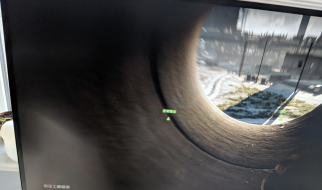
The spiral is the age-old intuitive symbol of spiritual development and our identity with the universe. It is found in cultures the world over and reflected in shamanism, serpent cults, dragon lore, geomancy, magic, mysticism and ritual art and dance throughout history.
As ?re-volution? or ?re-evolution?, the spiral progression is symbolic of the transpersonal route to that higher level of consciousness which is sought by all esoteric and occult systems. Paralleling these inner movements of the psyche which indicate the transformative and the integrative are movements in physical space: the vortex, or involution, representing an opening or re-awakening; the circumambulatory, as utilised in mazes and labyrinths; and oscillation, the movement back and forth between dualities. The circumambulatory and oscillative suggest the mandala, a symbol of wholeness, while the spiral and the vortex point to dynamic growth and metamorphosis.
Indeed, the spiral vortex, as found in whirlpools in water and in the double helix structure of the DNA molecule ? just two of myriad examples ? is nature?s favoured form for the transmission of its energy, both economically and efficaciously, radiating out and drawing in simultaneously, infinitely and eternally.
The archetypal image of the spiral came to render itself in the idea of a path that could be climbed in stages to reach God, a notion fundamental to both the Kabbalah and exponents of magic down the centuries, and made concrete in the three- and two-dimensional initiatory mazes which existed in antiquity.
It is believed that such mazes, or processional pathways, existed, for example, in England at Glastonbury Tor in Somerset and Godshill on the Isle of Wight. The one at the Tor may have been constructed as long as 5,000 years ago, according to certain estimates. Pilgrims would have entered the maze part way up the side of the hill and travelled first in a clockwise, then in an anti-clockwise, direction making their way to the holy summit, possibly by means of seven full circuits, absorbing the energy of the natural ?power station? as they went.
Similarly, the final phase of the construction of the 4,500-year-old Silbury Hill in Wiltshire comprised six terraces of chalk, with the seventh level being the summit. The great ziggurat of Babylon, the original Tower of Babel, was called the Etemenanki, the ?Temple of the Foundation of Heaven and Earth?, and its holy summit was reached by a spiral path ascending through seven tiers. The septenary spiral has been interpreted as the ?world centre? motif employed by Shambhala ? in Tibetan Buddhist tradition the mystical kingdom hidden in the Himalayas ? to convey its once dominant position as a seat of wisdom and knowledge.
Such places are indicative of the ?prototypical sacred and spiral mountain?, and represent the symbolic World Mountain of old, the omphalos, where above and below, the sky opening and the underworld, conjoin.
The labyrinth was joined inseparably with the mystery of life and death. Its false tracks and cul-de-sacs symbolised the sins and temptations which men and women had to resist on the journey to Heaven. As the mandala, or ?chart? of the progression of the soul, the symbolic spiritual journey along the spiral, towards God without or God within, depending on the direction travelled, through pilgrimage or meditation, appears in numerous traditions and cultures, representing the fusion and flow of dynamic opposites balanced in universal harmony, as exemplified in the Chinese yin-yang symbol.
The three circles, or planes, of spiritual evolution found in Druidic philosophy seem also to imply a spiral progression: the plane of Annwn, the great cauldron or creative void, gives rise to the material or human world of Abred which, in turn, leads to Gwynvyd, the plane of the fully developed spirit. On the first plane, matter is created, on the second, it takes physical form, and on the third, it attains perfection. It was the Cauldron of Annwn which, by way of Celtic myth, may have contributed to the symbol of the Holy Grail, the legend of which, while cultivated for Christian purposes, may be derived partially from Druidical sources. It has links to the classical Greek myth of the ?horn of plenty?, or cornucopia, the horn of the goat Amalthea which suckled the infant Zeus, and which frequently appears in a spiral shape.
The Grail Castle, indeed, could be the palace of Caer Sidi, which has been rendered in English as ?spiral castle?, in Annwn. Caer Sidi is mentioned in a poem, ?The Spoils of Annwn?, credited to the sixth-century Welsh bard Taliesin who, in some representations, is actually depicted as being born from a spiral form. Also translated as ?Circle of Revolution?, Caer Sidi was the temple of the Ceridwen, the Earth Mother (and Taliesin?s mother) and goddess of nature. Arianrhod, the Welsh goddess of time, karma and reincarnation, was said to dwell in a citadel at the centre of a spiral path.
In Tantric yoga, kundalini ? the Sanskrit word for ?spiral? and which also suggests ?serpent power? ? rises through the body through a series of seven energy centres, or chakras, the aim being to activate this spiritual and psychic energy by using various yogic techniques, and raise it from the lowest to the highest chakra. Kundalini is often depicted as a coiled serpent.
In Buddhist myths, legends, scripture and folklore, nagas comprise all kinds of serpentine beings ? snakes, deities of the primal ocean and of mountain springs, spirits of earth and the realm beneath it, and dragons ? and are inextricably bound up with ideas of rebirth and the constant regeneration of time.
One of the central ideas in my book, Spirals: the Pattern of Existence, is that the provenance of all serpent and dragon symbolism, and its relationship to earth energies which dowsers detect as running in spirals, lies in the spiral form in nature, the significance of which was intuited by the adepts, magicians or shamans of ancient times.
Effectively, the coils of the snake were superimposed on the spiral pattern and homologised, assuming its qualities and potentials. I believe this is how the serpent came to be a symbol of inexpressible cosmic forces and a metaphor for rebirth and spiritual renewal. It is interesting that the most spiritual animal, in the classical view, was the snake.
The eminent Swiss psychologist Carl Jung said the upward spiralling of the kundalini serpent symbolised ?the urge of realisation (which) naturally pushes man on to be himself?. For Jung, this involved the full realisation of the Self, through the natural and universal process of individuation, by which a person is existentially formed and differentiated. This work of becoming fully human, assisted by the will, is the work of the whole personality, embracing the Self, and of which the conscious ego is only a small and vulnerable component. Jung saw the individuation process as a spiral progression, to which he makes numerous references in his works.
So, spiral energy fields are all around us and within us, patterning our very existence, from microcosm to macrocosm, determining structures from the tiny vortices of sub-atomic particles and the DNA molecule to the awesome ?island universes? of galaxies where stars are born and the conditions for life created.
Indeed, the protean spiral is nature?s most favoured pattern of growth and most efficacious deployer of its energy ? life-inducing, life-protecting and life-supporting. Ultimately, the implication is that the spiral form is integral to strength and growth and indeed, it may be that all curves of growth are based on it. It is a powerful example of how nature tends to repeat the use of a successful design over and over again on every level of its creative handiwork.
One of the most beautiful manifestations of the spiral form in nature is the shell of the nautilus, a marine mollusc related to the squid, which approximates closely to the proportion of the Golden Ratio (1:1.618) which was integral to the geometry of antiquity in the construction of sacred buildings including the Giza Pyramids and the Greek Parthenon. The Ancient Egyptians? term for the Golden Ratio was ?neb?, translating as ?the spiralling force of the universe?, also meaning ?lord?, appearing in names of pharaohs, and used as one of the sacred names of the Sphinx.
There are countless examples of the spiral curve in the animal kingdom: the tusks of elephants and warthogs, the teeth of beavers and rodents, claws of cats, beaks of birds, horns of sheep, and the flight of birds. It is also found in the volutes of waves, the swirls of weather systems, and the shoots of plants, as well as in many aspects of human anatomy: the fibres in the ventricles of the heart run in spiral lines so that the muscular constriction by which the blood is forced onward, and the circulation kept up, is like the twist of a screw; in the ?labyrinth? of the inner ear, and coiled in the shape of a snail shell, is the cochlea, which analyses frequencies and consists of a spiral canal in which lies a smaller membranous spiral passage.
Archetypal thinking was typical of ancient thought processes, and so the spiral pattern has manifested itself in art, religion and philosophy from the oldest times, in occult belief or ?magical? systems, in earth divination and event patterning. It?s there in ancient art from all over the globe, from Stone Age societies in Europe and the Near East to pre-dynastic Egypt, in China and Peru, and throughout the history of Polynesian and Maori communities in the Pacific. This global phenomenon is part of the proof that humankind has always sought a dialogue with the forces of creation. The spiral is evidence that a spiritual technology, or structure, was in place ? a symbol that corresponds to the underlying reality of nature.
Etymologically, the word ?spiral? springs from ancient roots inextricably bound up with ideas of creation, life-giving and aspiration ? from the Latin spiralis or spira, and the Greek speira, meaning a spire or coil, or a conical or pyramidal structure, as well as from the Latin spirare, meaning ?to breathe,? as in expire and inspire. Tellingly, our word ?spirit?, representing the animating, non-material divine element in humans which gives life and reason, is drawn from the same semantic origins. Spirit, of course, is the vital, fundamental principle of existence, as well as those personal qualities such as courage, pride and vivacity of mind. And when you read the word ?spiritual?, have you noticed that you are seeing ?S-P-I-R-(itu)-A-L??
Now, the occultists? notion down the ages was that all phenomena contained something of the divine and that humanity, on a tiny scale, was a reflection of God and of the universe ? ?as above, so below, as within, so without?, the Hermetic dictum, attributed to Hermes Trismegistus (?three times great?), the Greek name given to the Ancient Egyptian god of wisdom Thoth, the legendary founder of magic. The authors of the Hermetic writings are unknown and it is likely that they spanned several centuries, the earliest being the second or third century BC.
The spiral is the perfect example of ?as above, so below, as within, so without?, weaving its magic from vanishingly small to unimaginably huge levels of existence. To me, the spiral is the ?way? of the universe, the link between microcosm and macrocosm, between science and spirituality; indeed, how the universe shapes up. It?s a uniting symbol right across nature and human culture, appearing as the sign of the eternal, creative and organising principle at work in the universe, as well as the pattern of our spiritual development ? a key to the riddle of existence and the inner essence of reality.
Travers Christmas Humphreys (1901?1983), founder of the Buddhist Society, writing in his Karma and Rebirth (1943), gives us this wonderful analogy: ?Man has many levels of cognition, windows on the spiral staircase of his understanding, and even as the lighthouse-keeper, whose tower is based in the living rock, climbs to the level of the lantern where he tends the light which is not his light, so man?s evolving consciousness must climb from plane to plane until he finds, and learns to tend, the Light within, which shines eternally.?
- Spirals: the Pattern of Existence by Geoff Ward, with an introduction by Colin Wilson, is published by Green Magic (2006, 2nd edition 2013, ISBN 0 9547 2309 0)


